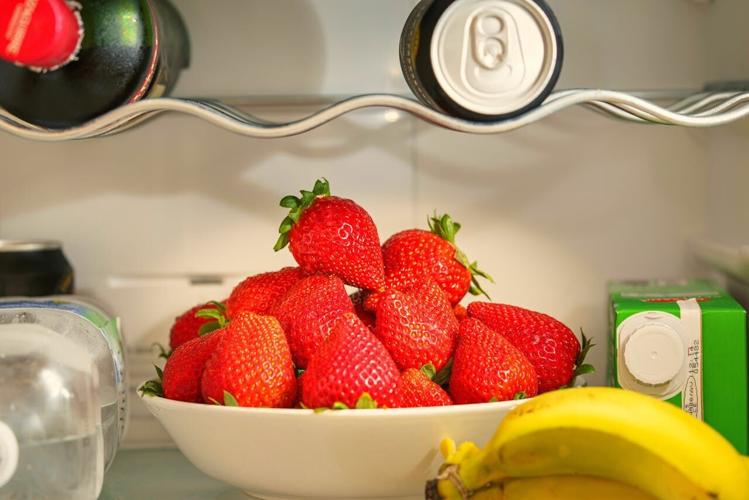
(Photo by Ramon Perucho via Pexels)
By Stephen Beech
Strawberries could get an extended shelf life thanks to a new edible coating.
Fruit coated with the biofilm lost less weight during storage and took much longer to start becoming contaminated by fungi, without losing its aroma or flavor.
And economic analysis indicates that the coating could cost just two pence per fruit.
The new material is based on pomegranate peel extract obtained from agricultural and fishing waste.
It was developed by researchers at the São Carlos Institute of Chemistry of the University of São Paulo (IQSC-USP) in Brazil.
In lab tests, the team found that over 12 days of refrigerated storage, strawberries coated with the film lost 11% weight and took between six and eight days to start becoming contaminated with fungi, compared to four days for fruit not covered with the material.
Study first author Dr. Mirella Bertolo said: “By applying the coating, it was possible to double the shelf life of strawberries kept under refrigeration and delay the dehydration of the fruit, while preserving the taste, texture and volatile compounds that give the fruit its characteristic aroma."
She began the work during her doctoral studies under the supervision of Professor Stanislau Bogusz Junior.

Process of coating strawberries with biofilm. (Mirella Romanelli Vicente Bertol via SWNS)
During their research, they developed a technique that allowed them to extract 84.2% more antioxidants - substances with preservative properties - from the peel of pomegranate using natural deep eutectic solvents (NADES).
Bogusz said: “More than 40% of the pomegranate, depending on the variety, is made up of peel, which is wasted.
"Our idea was to use this waste to obtain extracts rich in phenolic compounds with antioxidant and antimicrobial activities."
With the success of developing the extraction method, the team decided to test the hypothesis of incorporating the antioxidants in pomegranate into coatings based on gelatin and chitosan, a polymer found in the skeletons of crustaceans such as shrimp, to develop a protective film for fruit.
Bogusz said: “We chose to use chitosan extracted from squid inner shells through a process of deacetylation of the chitin found in this mollusc, because it doesn’t have the problem of allergenicity like that obtained from shrimp.
"And we combined this material with another polymer, in this case gelatin, to improve its mechanical properties."

(Photo by Jonathan Einwechter via Pexels)
He explained that the strawberry was chosen as a model system to test the effectiveness of the biofilm because it is one of the items with the highest loss rates in Brazilian supermarkets due to its perishability and short shelf life of less than seven days under refrigeration.
Bogusz said: “The strawberry is a fruit that has very high respiratory activity and a very low acidity.
"It’s therefore very susceptible to microbial attack. It’s also very moist and the fruit is small.
"Based on this, we hypothesized that if the material we developed worked, it’d be effective on any other fruit.”
To test the hypothesis, the research team coated strawberries with the edible film by immersion and evaluated the effects of the material on the physicochemical, microbiological and sensory characteristics of the fruit over 12 days of refrigerated storage.
The results, published in the journal Food Chemistry, indicate that the material forms a film on the surface of the fruit that acts as a barrier to the passage of microorganisms, moisture loss and gas exchange, modifying the strawberry’s respiration.
The researchers say the coating slows down the metabolism of the fruit during the post-harvest period, thereby increasing its shelf life and preserving the color, firmness and bioactive compounds of the fruit.

(Photo by Alex P via Pexels)
Dr. Bertolo said: “We found that the film made it possible to maintain the texture, delay contamination by microorganisms and reduce the loss of fruit mass, which is observed when the strawberry shrivels.
"This happens very often with uncoated fruit because it easily loses water and dehydrates."
She said the film also made it possible to reduce the severity of fungal damage and improve the volatile profile of the fruit, adding: “The material made it possible to preserve 40% more of the compounds responsible for the fruit’s aroma.”
Dr. Bertolo says the biofilm also didn’t interfere with the sensory characteristics of the fruit, such as flavor, as confirmed by sensory analysis tests.
She said: “The results of the tests showed that there were no differences in the taste, aroma or visual characteristics of strawberries coated with the material compared to strawberries without the film."
The researchers have filed a patent application for the formulation and intend to license the technology to interested firms.
Dr. Bertolo said of the estimated cost of the coating: “This is a cost that consumers may be willing to pay for fruit with a longer shelf life and greater usage."







